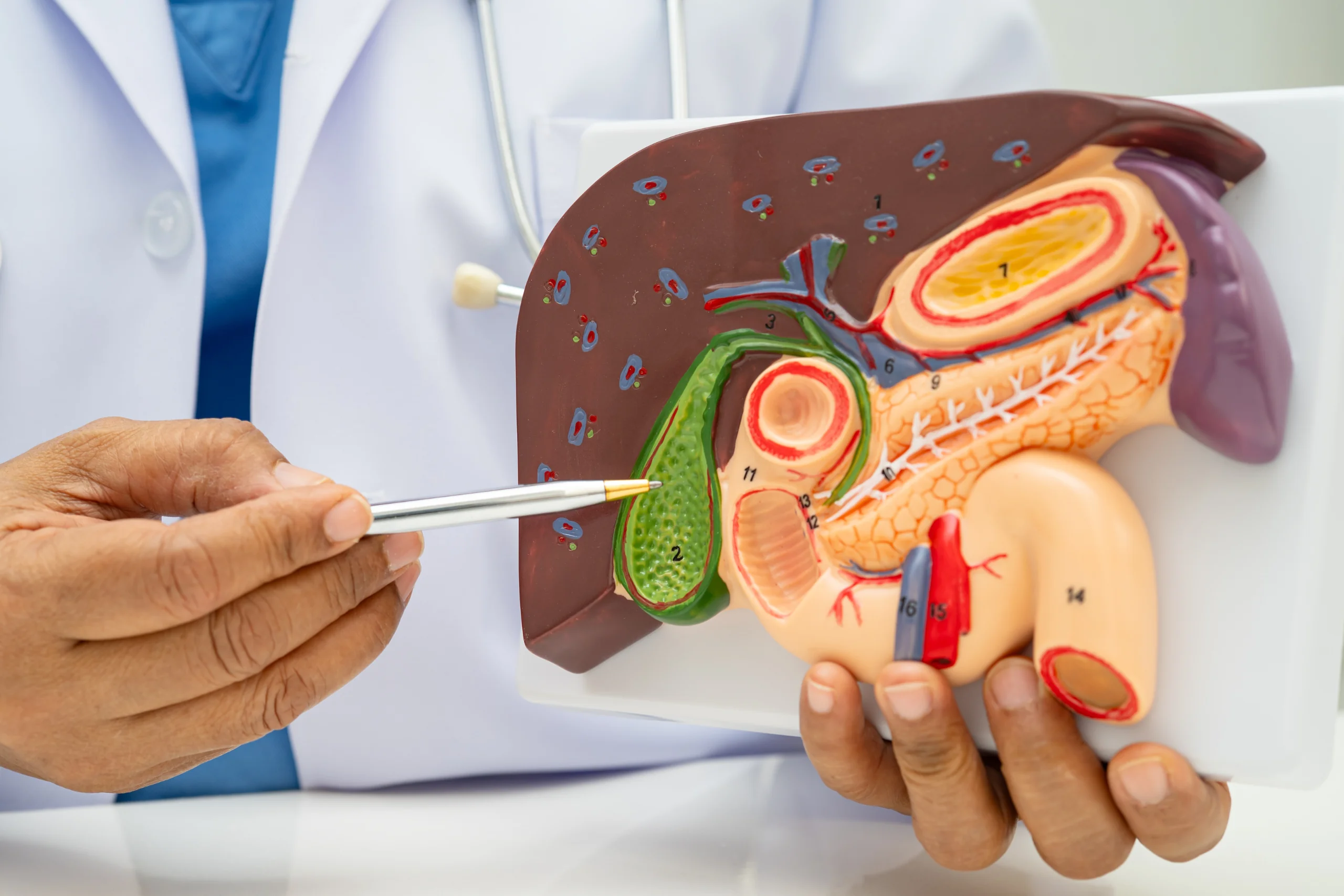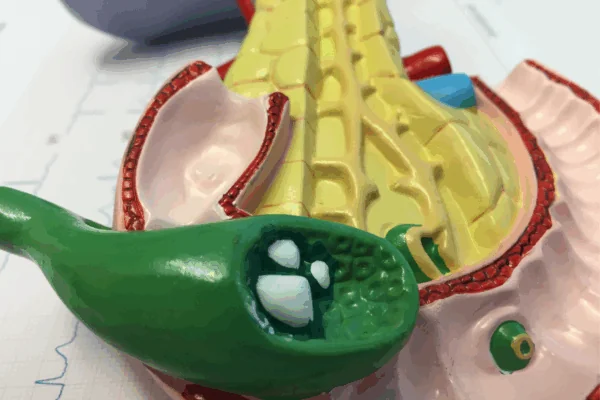Gallbladder removal surgery, known medically as laparoscopic cholecystectomy, is one of the most performed general surgery operations in the UK. It is usually recommended to treat painful gallstones and related conditions such as gallbladder inflammation (cholecystitis) or pancreatitis caused by stones blocking the bile ducts.

On this page
The Gallbladder and Gallstones
The gallbladder is a small, pear-shaped organ that sits just beneath the liver. Its job is to store bile, a digestive fluid made by the liver that helps break down dietary fats. Gallstones are solid deposits, often made of cholesterol or bile pigments, that can form inside the gallbladder.
Many people have gallstones without symptoms, but for others, they can cause:
• Severe abdominal pain (biliary colic), often after fatty meals
• Nausea, indigestion, or bloating
In some cases, gallstones can lead to complications such as:
• Cholecystitis – inflammation of the gallbladder, often with fever and severe pain
• Pancreatitis – inflammation of the pancreas when stones block the bile ducts
• Jaundice – yellowing of the skin and eyes due to obstructed bile flow
If left untreated, these conditions can become serious. That’s why surgical removal of the gallbladder is often the safest and most effective treatment.

When Do You Need Gallbladder Removal Surgery?
Not everyone with gallstones requires treatment. If your gallstones are “silent” (causing no symptoms), surgery is usually unnecessary. However, gallbladder removal surgery, also known as gallstone removal surgery, is often recommended if you:
• Experience recurrent abdominal pain caused by gallstones
• Have developed gallbladder inflammation or infection
• Suffer from gallstone-related pancreatitis
• Are at risk of further or ongoing complications
At Phoenix Health, your consultant surgeon will carefully assess your medical history, lifestyle, and test results before advising whether surgery is the right option for you.
Types of Gallbladder Surgery
Laparoscopic Cholecystectomy (Keyhole Surgery)
This is by far the most common and preferred way to remove the gallbladder. The surgeon makes a few small cuts in the abdomen and inserts a thin camera (laparoscope) and fine instruments to carefully remove the gallbladder. Because it is minimally invasive, recovery is usually faster than with open surgery. Most patients can go home the same day or after an overnight stay, and post-operative discomfort is generally mild and short-lived.
Open Gallbladder Surgery
In some cases, open surgery may be required either because laparoscopic (keyhole) surgery is not suitable, or if complications arise during the procedure. In this method, the surgeon makes a single larger incision in the abdomen to remove the gallbladder. The likelihood of needing an opens surgery for gallbladder removal is generally low (2-5%). Although this approach is less common (needed in only a small percentage of cases), it can be the safest option for certain patients. Recovery usually takes a little longer than with keyhole surgery, and most patients stay in hospital for a few days before going home
What to Expect Before, During, and After Gallbladder Removal Surgery
Preparing for Surgery
Before your operation, you will have an assessment that may include blood tests, an ultrasound scan, and sometimes an MRI (MRCP) to check the bile ducts. Your Phoenix Health surgeon will explain the procedure in detail, review your medications, and answer any questions you may have.
The Procedure – Laparoscopic Cholecystectomy
During the operation, you will be given a general anaesthetic so that you are fully asleep and comfortable. The procedure usually takes around 1 hour, depending on your individual circumstances.

For most patients, the operation is performed by keyhole (laparoscopic) surgery:
• Several small cuts are made in the abdomen.
• The area is gently inflated with carbon dioxide gas to provide space and visibility.
• A fine camera and slender instruments are used to carefully detach and remove the gallbladder through one of the openings.
• The incisions are closed with dissolvable stitches and sealed with surgical glue. Occasionally, external stitches or staples are used.
Open cholecystectomy may be required in a small percentage of cases. Here, the surgeon makes a single larger incision in the upper-right side of the abdomen under the right rib cage edge.
Immediately After Surgery
You will usually wake up in the recovery area and be able to drink fluids within a few hours. Most patients go home the same day or after an overnight stay. Pain is typically mild and controlled with tablets.
Recovery time for gallbladder Removal surgery
Recovery after laparoscopic gallbladder surgery is usually quick:
• First few days – mild abdominal discomfort, bruising around the cuts, and tiredness. Gentle walking is encouraged.
• 1–2 weeks – stitches dissolve or are removed; many patients return to light activities or desk-based work.
• 2–4 weeks – most people are back to normal daily life. Strenuous exercise or heavy lifting should be delayed until your consultant confirms it is safe.
Your surgeon will tailor advice to your job and lifestyle , desk-based workers may return sooner than those with physically demanding roles.

Side Effects and Risks
Laparoscopic cholecystectomy is a safe and effective operation. Most side effects are mild and temporary, but all surgery carries risks. These may include:
• Temporary bloating, diarrhoea, or indigestion
• Shoulder tip pain from the gas used during surgery
• Infection at the wound site
• Rare risks such as bleeding, retained stones, bile leak or bile duct injury
Your surgeon will discuss these risks with you beforehand so you can make an informed decision.

Diet After Gallbladder Removal Surgery
Most people digest food normally without a gallbladder, as the liver continues to release bile directly into the intestine. In the first few weeks, some people may notice loose stools or bloating.
To help recovery:
• Avoid very fatty, spicy, or heavy meals at first
• Eat smaller, more frequent meals
• Drink plenty of fluids
Most patients gradually return to a normal, unrestricted diet. At Phoenix Health, we provide tailored aftercare and dietary guidance to support your recovery.

Why Choose Phoenix Health for Gallbladder Removal Surgery?
Expert surgeons – all consultants are highly experienced in laparoscopic cholecystectomy. Personalised care – we provide detailed pre-operative guidance and ongoing aftercare. Rapid access – no long NHS waiting lists; surgery can usually be arranged promptly within 2 to 4 weeks. Patient satisfaction – consistently high feedback and excellent outcomes. Our aim is to give you peace of mind, smooth recovery, and long-term relief from gallstone pain.

How Much Does Gallbladder Removal Surgery Cost in the UK?
The cost of gallbladder removal surgery in the UK can vary depending on your individual needs and the type of care provided. At Phoenix Health, we offer clear and competitive pricing packages that include expert surgical treatment, dedicated aftercare, and full support to ensure a smooth recovery. For detailed information on gallbladder surgery costs and what’s included, please contact our team today. we’re here to guide you every step of the way.

Get in touch